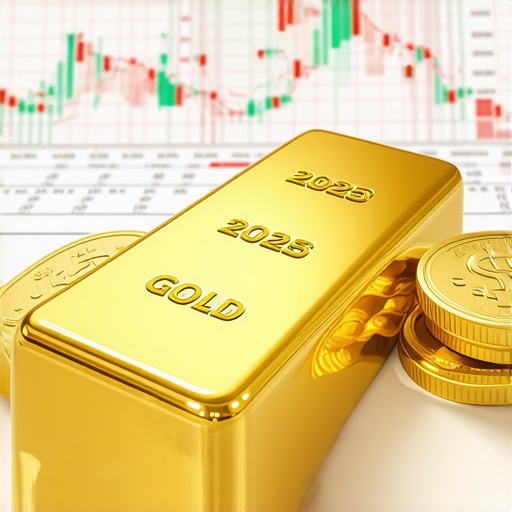Understanding Physical Gold Investment vs. Digital Gold: An Overview
As investors seek opportunities to diversify their portfolios, the debate between physical gold investment and digital gold has gained significant traction. Both forms have unique advantages and drawbacks that can influence an investor’s decision. Understanding these differences is essential for making an informed choice that aligns with your investment strategy.
The Appeal of Physical Gold Investments
Investing in physical gold offers tangible benefits that many investors find appealing. First and foremost, physical gold provides a sense of security. Holding gold bars, coins, or jewelry creates a psychological comfort that digital assets often lack. In times of economic uncertainty, physical gold acts as a hedge against inflation and currency devaluation, making it a safe haven for wealth preservation.
Moreover, physical gold can be an excellent way to avoid the risks associated with digital transactions and cyber threats. As a concrete asset, it is not subject to hacking or digital fraud, which is increasingly pertinent in today’s technology-driven world.
Drawbacks of Physical Gold Investment
However, investing in physical gold is not without its challenges. One major drawback is the costs associated with storage and insurance. Safeguarding physical gold requires secure facilities, which can incur additional expenses. Additionally, selling physical gold can be more complicated than liquidating digital assets, as it often necessitates finding a buyer and possibly incurring dealer fees.
The Rise of Digital Gold Investments
Conversely, digital gold investments have gained popularity due to their convenience and accessibility. Digital platforms allow investors to buy and sell gold with just a few clicks, making it easier to manage your investment portfolio. Furthermore, digital gold often comes with lower transaction fees compared to physical gold, making it a cost-effective option for many investors.
Digital gold investments also offer liquidity that physical gold cannot match. Investors can quickly convert their digital gold into cash without the hassle of finding a buyer or incurring significant costs. This liquidity is particularly appealing for those looking to capitalize on market fluctuations.
Challenges with Digital Gold Investments
Despite its advantages, digital gold investments also have their drawbacks. The primary concern revolves around security and ownership. Unlike physical gold, which can be stored in a secure location, digital gold is subject to the vulnerabilities of online platforms. Investors must trust that their digital assets are stored safely and that the platform they use adheres to robust security measures.
Additionally, digital gold lacks the intrinsic value and emotional connection that many investors find in physical gold. The experience of holding a tangible asset is irreplaceable for some, and this aspect can significantly impact investment decisions.
Making an Informed Choice
Ultimately, the decision between physical gold investment and digital gold comes down to personal preferences and investment strategies. For those prioritizing security and tangible assets, physical gold may be the preferred option. However, if you value convenience and liquidity, digital gold could be the better choice. Understanding the pros and cons of each investment type is essential for aligning your choices with your overall financial goals.
Assessing Your Investment Goals in Gold
Before diving into the world of gold investments, it’s crucial to evaluate your investment goals. Are you looking for long-term wealth preservation, short-term trading opportunities, or a hedge against inflation? Understanding your objectives will help guide your choice between physical gold and digital gold investments.
Long-Term vs. Short-Term Investment Strategies
For long-term investors, physical gold often serves as a reliable store of value, especially during economic downturns. Conversely, if you are interested in short-term trading, digital gold platforms can provide the agility needed to capitalize on market movements quickly. The flexibility of digital gold allows for rapid transactions, making it appealing for day traders.
Risk Tolerance and Market Volatility
Your risk tolerance also plays a significant role in determining which type of gold investment is better suited for you. Physical gold tends to be less volatile, providing stability during turbulent market conditions. However, digital gold can exhibit price fluctuations that may be beneficial for those willing to take on additional risk for potentially higher returns.
Understanding Fees and Costs Associated with Gold Investments
Investors should also be aware of the various fees and costs associated with both physical and digital gold investments. Physical gold incurs expenses for storage, insurance, and transaction fees when buying or selling. On the other hand, digital gold may feature lower transaction fees, but investors should scrutinize the platform’s service charges, which can vary significantly.
Storage Solutions for Physical Gold
Choosing a secure storage solution is paramount for physical gold investments. Options include bank safety deposit boxes, private vaults, or even at-home storage. Each comes with its own set of advantages and challenges. For instance, while safety deposit boxes provide security, they can be costly and may limit your access to the gold.
Digital Gold Security Measures
When it comes to digital gold, security is a pressing concern. Ensure that the platform you choose employs robust security protocols, like two-factor authentication and encryption. Additionally, consider platforms that offer insurance in case of breaches or losses, adding an extra layer of protection to your investment.
Market Trends Influencing Gold Prices
Staying informed about current market trends is essential for any investor. Factors such as inflation rates, interest rates, and geopolitical events can significantly impact gold prices. Investors should regularly consult resources like gold price forecasts and market analyses to make informed decisions.
The Role of Central Banks in Gold Demand
Central banks play a vital role in shaping gold demand and prices. When central banks increase their gold reserves, it typically drives up prices due to heightened demand. Keeping an eye on central bank policies can provide valuable insights into potential price movements and investment opportunities.
Investing in Gold During Economic Uncertainty
Gold is often viewed as a safe haven during economic uncertainty. As inflation rises or financial markets become unstable, many investors flock to gold to preserve their wealth. Understanding how to leverage this trend can enhance your investment strategy, whether you choose physical gold or digital alternatives.
Evaluating the Best Types of Gold Investments for Your Portfolio
When considering gold investments, it’s essential to understand the various options available. Each type has its own benefits and drawbacks, making it crucial to choose one that aligns with your financial goals. The main categories of gold investments include physical gold, gold ETFs, and gold stocks. By evaluating these options, you can make an informed decision tailored to your investment strategy.
Physical Gold: Coins, Bars, and Jewelry
Investing in physical gold often involves purchasing coins, bars, or jewelry. Coins, such as the American Gold Eagle or Canadian Maple Leaf, are highly sought after for their liquidity and recognizable value. Gold bars, typically available in various weights, are ideal for investors looking to maximize their investment in a single purchase. Jewelry, while often less pure, can also serve as a form of gold investment, though it may carry additional design and craftsmanship costs.
Gold ETFs: A Flexible Investment Option
Gold Exchange-Traded Funds (ETFs) offer an accessible way for investors to gain exposure to gold without the need for physical storage. These funds track the price of gold and can be bought and sold like stocks on major exchanges. Investing in gold ETFs can be advantageous for those seeking liquidity and lower transaction costs. However, investors should carefully evaluate the ETF’s expense ratios and underlying assets.
Gold Mining Stocks: Potential for Higher Returns
Gold mining stocks can present opportunities for higher returns compared to physical gold and gold ETFs. By investing in companies that extract gold, you may benefit from price appreciation based on the company’s performance and the underlying gold prices. However, this type of investment carries additional risks, such as operational issues and market volatility. Therefore, it’s important to conduct thorough research before diving into gold mining stocks.
Understanding the Impact of Economic Indicators on Gold Prices
Gold prices are influenced by various economic indicators, including inflation rates, interest rates, and currency strength. Monitoring these factors can help investors make timely decisions regarding their gold investments. For instance, rising inflation often leads to increased gold demand as investors seek a hedge against currency devaluation.
The Relationship Between Interest Rates and Gold Prices
Interest rates play a critical role in determining the attractiveness of gold as an investment. Generally, lower interest rates decrease the opportunity cost of holding gold, leading to higher demand and prices. Conversely, when interest rates rise, the appeal of gold may diminish as investors shift to interest-bearing assets. Keeping an eye on central bank policies can provide insights into prospective shifts in gold prices.
Geopolitical Factors Affecting Gold Demand
Geopolitical events, such as conflicts or political instability, can create uncertainty in financial markets, driving investors towards gold as a safe haven. Understanding these dynamics can be vital for timing your entry into gold investments. Historical trends indicate that during periods of unrest, gold prices often rise as demand surges. Monitoring news and geopolitical developments can assist investors in identifying potential opportunities.
Analyzing Gold Market Trends: Insights for 2025 Investors
As we venture further into the complexities of gold investments, understanding market trends becomes crucial for maximizing returns. Investors must stay informed about fluctuations in gold prices and broader economic indicators that influence these trends. A detailed analysis of the current market landscape can provide clarity on potential investment opportunities.
Monitoring Global Demand for Gold
The demand for gold is shaped by a variety of factors, including consumer behavior, industrial usage, and investment trends. In 2025, it will be essential to monitor how global demand shifts, particularly in emerging markets. Countries like India and China remain significant consumers of gold, largely driven by cultural factors and rising wealth levels. Understanding these dynamics can inform your investment strategy as you assess the best types of gold investments available.
The Role of Central Banks in Gold Prices
Central banks play a pivotal role in shaping the gold market through their buying and selling activities. In recent years, many central banks have increased their gold reserves as a hedge against economic uncertainty. This trend is expected to continue into 2025, potentially driving up demand and prices. Investors should keep a close watch on central bank policies and inventory levels, as these can significantly impact market dynamics.
Investment Strategies for Capitalizing on Gold Trends
To successfully navigate the ever-changing landscape of gold investments, it is essential to adopt effective investment strategies. These strategies should be tailored to your financial goals and risk tolerance. Here are some approaches to consider:
Diversifying Your Gold Portfolio
Diversification is key to reducing risk in any investment portfolio. By including a mix of physical gold, gold ETFs, and gold mining stocks, investors can better shield themselves from market volatility. Each type of gold investment offers unique advantages and risks, making it advantageous to spread your investments across various categories.
Staying Informed About Market Conditions
Continuous education about market conditions is vital for gold investors. Regularly consulting resources such as gold price forecasts and expert analyses can provide valuable insights. Additionally, following gold price trends can help you anticipate market movements and make informed decisions about buying or selling your gold assets.
Conclusion: Preparing for the Future of Gold Investments
As you prepare for the future of gold investments in 2025, remember to consider the multifaceted nature of the gold market. By analyzing ongoing trends, understanding the impact of global demand, and employing strategic investment methods, you can position yourself for success. Whether you’re a seasoned investor or just starting your journey in investing in gold, staying informed and adaptable will be your keys to unlocking the full potential of your gold portfolio.
Frequently Asked Questions about Gold Investments
What factors influence gold prices?
Gold prices are influenced by various factors including global economic conditions, inflation rates, currency values, and changes in demand from both consumers and central banks. Understanding these factors can help investors make informed decisions about their gold investments.
Is investing in gold a safe option?
Investing in gold is often considered a safe haven during economic uncertainty. Gold can act as a hedge against inflation and currency fluctuations, making it a popular choice for risk-averse investors. However, like any investment, it carries risks, and it’s essential to conduct thorough research.
How can I start investing in gold?
To start investing in gold, you can consider various options such as purchasing physical gold (jewelry, coins, bars), investing in gold ETFs, or buying stocks in gold mining companies. Assess your financial goals and risk tolerance to choose the right investment type for you.
What is the best way to diversify my gold investments?
Diversifying your gold investments can be achieved by including a mix of physical gold, gold ETFs, and gold mining stocks in your portfolio. This approach can mitigate risks and provide exposure to different aspects of the gold market.
How often should I review my gold investment portfolio?
Regularly reviewing your gold investment portfolio is crucial, especially during significant market fluctuations. It’s advisable to assess your portfolio at least quarterly or after any major economic events to ensure it aligns with your financial goals.
What are the tax implications of investing in gold?
The tax implications of investing in gold vary by jurisdiction. In many countries, profits from selling gold are subject to capital gains tax. It’s essential to consult a tax professional to understand the specific tax laws relevant to your gold investments.
Are there any risks associated with gold mining stocks?
While gold mining stocks can offer significant returns, they also come with specific risks, including operational challenges, fluctuating production costs, and geopolitical issues in mining regions. Investors should conduct thorough due diligence before investing in mining stocks.
How can I stay updated on gold market trends?
Staying updated on gold market trends can be achieved by following financial news outlets, subscribing to gold market analysis reports, and joining investment forums. Engaging with expert opinions and market forecasts can enhance your understanding of the gold market.
What role do geopolitical events play in gold prices?
Geopolitical events can significantly impact gold prices as they often lead to market volatility and economic uncertainty. Events such as political instability, trade wars, and conflicts can drive investors toward gold as a safe asset, increasing demand and prices.
Authority Resources for Gold Investment Insights
For those looking to deepen their knowledge and stay informed about gold investments, the following resources provide comprehensive insights:
- World Gold Council – Offers extensive research and insights on gold market trends, demand, and the role of gold in investment portfolios.
- Kitco – Provides live gold prices, market analysis, and news related to precious metals.
- Investing.com – A platform for financial news, analysis, and real-time data on gold and other commodities.
- Bloomberg Commodities – Offers up-to-date information on commodities, including gold, with in-depth market analysis.
- Forbes – Features articles and expert insights on investing, including gold market trends and investment strategies.
Conclusion: Embracing the Future of Gold Investments
As we look ahead to 2025, the gold market presents both opportunities and challenges for investors. By understanding market trends, implementing effective investment strategies, and staying informed through credible resources, investors can make educated decisions that align with their financial goals. The key to successful gold investment lies in careful analysis, diversification, and adaptability in an ever-changing economic landscape. Embrace the potential of gold investments and position yourself for success in the upcoming years.










